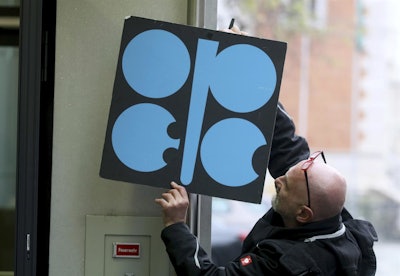
The OPEC cartel and a group of allied oil-producing nations agreed Thursday to prolong crude output cuts until the end of next year, extending a policy that has led to a significant rise in the price of oil over the past year.
At the same time, the 24-nation alliance led by OPEC member Saudi Arabia and Russia gave notice that they stand ready to revisit the move, should price increases bring U.S. shale operators — who had suspended operations while crude was cheap — back into the market in force.
"We are going to be agile, depending on how events unfold," Saudi Arabian oil minister Khalid Al-Falih told reporters. Announcing the decision after a day of meetings, he declared, "it's been a great day."
The success of the strategy has been reflected by crude's rise. Benchmark oil prices are now close to $60 a barrel, depending on the grades, up almost 20 percent since a year ago. On Thursday, the U.S. contract was trading at $57.08 a barrel, down 22 cents on the day.
 A worker attaches a poster of the Organization of the Petroleum Exporting Countries, OPEC, at their headquarters in Vienna, Austria, Wednesday, Nov. 29, 2017. With bills rising for gasoline or heating oil, consumers around the world are paying the price for a decision by OPEC and Russia last year to cut production. The strategy is working for those oil-producing nations and will likely be extended at a meeting Thursday. (AP Photo/Ronald Zak)
A worker attaches a poster of the Organization of the Petroleum Exporting Countries, OPEC, at their headquarters in Vienna, Austria, Wednesday, Nov. 29, 2017. With bills rising for gasoline or heating oil, consumers around the world are paying the price for a decision by OPEC and Russia last year to cut production. The strategy is working for those oil-producing nations and will likely be extended at a meeting Thursday. (AP Photo/Ronald Zak)That will partly reflect a rise in global economic growth since last year. But is also attributed to the OPEC-led decision last year to limit production, renewing the cartel's reputation as a major player in controlling the oil market.
After decades of being a dominant force in determining supplies and prices, OPEC's role as a key regulator started fading in recent years, as U.S. shale producers started pumping up their output. That led to oversupply and a steep fall in prices from over $100 to below $40 a barrel by last year, leading to the decision to join key non-OPEC nations and jointly pump less crude.
But the strategy of continued cuts to drive up prices may not be sustainable over the longer run, and OPEC may yet see its influence wane again. With prices now at two-year highs, U.S. producers who mothballed operations when oil was cheap are coming back into the market in force. U.S. oil producers need relatively higher market prices to break even than, say, Saudi Arabia. So the recent rise is encouraging more to start pumping again.
U .S. crude oil production already has grown by 15 percent since last year to nearly 10 million barrels per day, just behind Russia and Saudi Arabia. The International Energy Agency expects the U.S. to become the biggest net exporter by the end of the 2020s.
The extra crude is welcome for now, with the global economy booming. But at some point the balance could again tip from relatively tight supplies to an oversupply, and a drop in prices.






















